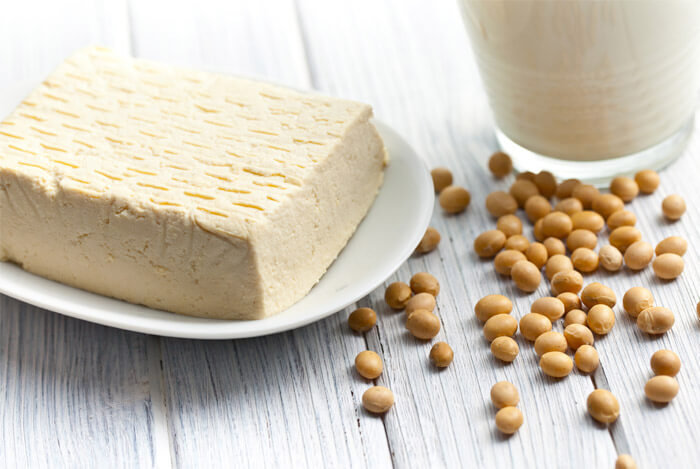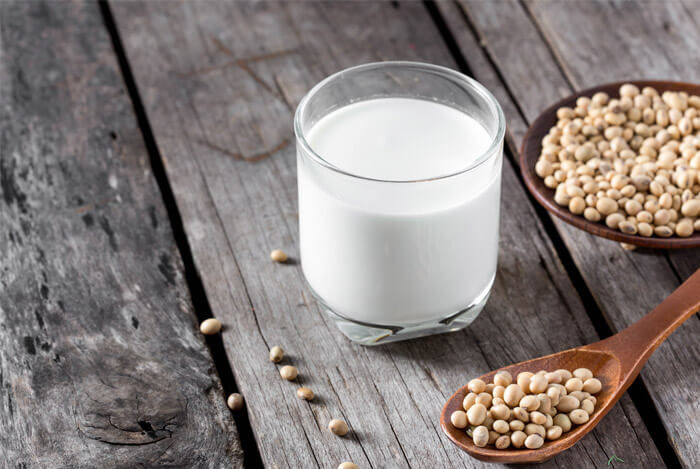Soy has become pretty popular recently. You can find it in most supermarkets in the form of soy milk, tofu, or meat/dairy substitutes.
But there is also a considerable amount of controversy around soy itself. While it is used commonly to treat a number of health issues, there are also certain concerns about whether or not it is as healthy as it seems.
So what’s the real deal about soy? Is it an awesome superfood or an unhealthy, hormone disrupting food that should be avoided?
Let’s investigate whether soy is healthy or harmful.
- What is Soy?
- Nutrients Found in Soy
- Benefits of Soy
- Potential Dangers of Soy
- Conclusion: Healthy or Harmful?
Table of Contents
+What is Soy?

Soy comes from the soybean, a legume originating in East Asia that is now produced on a much larger scale in the United States.
In the 1920s, the soybean was established as a commercial crop in the US, but it wasn’t truly incorporated into American diets until World War II, when imported fats and oils were limited because of disrupted trade routes. By the 1960s, the US was producing 75% of the world’s supply.
Because of how cheap soybeans are to produce and because of its many functional properties, soy has been included in many processed foods. So even if you don’t go out looking for it specifically, you’ll probably end up consuming soy in one form or another.
Soy can be processed into soy protein powder, made into a beverage like soy milk, or turned into the more fibrous soy fiber. The soybean itself must be cooked when prepared, or else it can be poisonous when consumed.
Nutrients Found in Soy

Before we dive into the controversy surrounding the benefits and dangers of soy, let’s find out exactly what’s inside every bean.
Soy contains large amounts of:
- Manganese
- Selenium
- Potassium
- Phosphorous
- Molybdenum
- Magnesium
- Calcium
- Copper
- Vitamin B6
- Folate
- Iron
- Vitamin B2
- Thiamin
- Vitamin K
A 3.5 ounce serving of soy contains 173 calories with 9 grams of fat, 10 grams of carbs, 6 grams of fiber, as well as 17 grams of protein.
Soybeans also contain some lesser known nutrients that have only been recognized within the past few decades for their benefits, including:
- Flavonoids
- Isoflavonoids
- Phenolic Acids
- Phytoalexins
- Phytosterols
- Proteins and peptides
- Saponins
Benefits of Soy
At this point in scientific research, there have been many, many studies performed on soy to determine its health benefits. And to be honest, it’s pretty much a wash.
Cancer Prevention

Many studies show evidence supporting the role whole soy foods play in a diet built to prevent cancer. Genistein, one of the isoflavonoid phytonutrients found in soy, is most often focused on in these studies.
Genistein can increase the activity of a tumor suppressor protein called p53. When p53 becomes more active, it can encourage cell death (apoptosis) in cancer cells, and prevent cancer cells from producing new cells.
This isoflavonoid has also been demonstrated to block the activity of tumor formation, especially in the case of breast and prostate cancer.
However, it is worth noting that the amount of genistein required to trigger these anti-cancer effects is somewhat high – far higher than the amount provided in a typical serving of soybeans.
Among women with breast cancer, soy consumption was associated with a significantly reduced risk of death and recurrence. Another study showed that soy could reduce risk of colon cancer in women, but not in men.
Cardiovascular Benefits

Some studies have shown soybean’s ability to effect blood fats, leading to a moderate lowering of LDL cholesterol. Other studies have demonstrated positive impacts like the lowering of triglycerides and total cholesterol, along with the raising of “good” HDL cholesterol.
Phytonutrients found in soy called soyasaponins have drawn considerable attention from researchers because of their link to cardiovascular benefits.
Animal studies have shown that these soyasaponins can lessen the rate of absorption of cholesterol from the gastrointestinal tract and increase the excretion of fecal bile acids, both of which are connected to decreased risk of cardiovascular disease. However, more research is needed to confirm whether or not soyasaponins are truly a heart-healthy part of a balanced diet.
Bone Health

A study published in the Archives of Internal Medicine in 2005 found that soy intake was associated with a significantly lower risk of bone fracture, especially among women who were postmenopausal.
More than 24,000 postmenopausal women in China were studied, and after 4 ½ years, researchers determined that the women who had the highest soy consumption were 35-37% less likely to suffer bone fractures than women in the group with lowest consumption.
Many soy products are naturally high in calcium, the coagulating agent that helps build strong bones. Soy also contains magnesium, which is also very important to bone health.
While this and other studies have shown soy protein to be overall beneficial for bone health, more research is still required to figure out whether these benefits are due to the soy protein itself, or other contributing nutrient factors.
Potential Dangers of Soy
Many concerned with public health have started to question the prevalence of soy in modern diets.
But what evidence do we have to suggest that soy could actually be harmful?
Hormone Effects in Men

Soy contains large amounts of isoflavones that function as phytoestrogens. These compounds can activate estrogen receptors in the human body.
These isoflavones are categorized as endocrine disruptors because of the ways they interfere with the normal function of your body’s hormones. When acting as phytoestrogens, your bodies natural estrogen is unable to bind with receptors and leads to increased estrogen activity.
This can lead to some negative effects in men like gynecomastia, decreased or swings in libido, or lactose intolerance.
Rat studies have shown exposure to soy isoflavones in the womb can lead to adverse sexual development in males.
In one study, men who consumed the most soy in a 3 month period were shown to have the lowest sperm count – though this is only reported as a statistical correlation and not demonstrative proof.
Breast Cancer

The estrogen activity of the isoflavones in soybeans is the reason why isoflavones are often used as alternatives to drugs given to relieve symptoms of menopause. But, this is not usually prescribed by health professionals. Isoflavones have actually been shown in animal studies to cause breast cancer.
One study broke 48 women into two groups. One group ate a normal diet while the other group took 60 gram soy protein supplements. The group who consumed soy protein had significant increases in the proliferation of epithelial cells in the breasts. These are the cells that are most likely to become cancerous.
Another similar study demonstrated a 29.2% increased number of breast epithelial cells in 7 of 24 women when they took soy protein supplements.
Other, smaller studies have shown soy to cause mild disruptions of the menstrual cycle, leading to delayed or prolonged menstruation.
Conclusion: Healthy or Harmful?

To conclude one way or the other definitively would be somewhat dishonest, yet many health gurus out there on the internet and on television will be quick to jump onto either bandwagon.
Many recommend more soy in your diet, while others try and shout supporters down by pointing out the studies that show the negative effects.
When you pay attention to the actual researchers involved in these studies, their conclusions seem pretty clear: we are only just now beginning to understand the nature of soy, and more research is required for anyone to make firm recommendations about it.
Most of the studies that have shown negative effects used extremely high doses, more than you’d typically consume. It’s unlikely small amounts of soy products, like soy sauce, would cause problems.
That said, it’s probably worth erring on the safe side and not adding large doses of soy to your normal diet.









